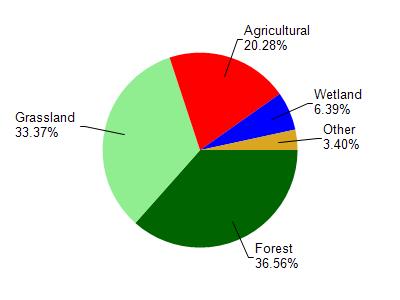Vernon
No
No
No
Fish and Aquatic Life
Overview
Beaver Creek is a small size spring-fed tributary of the South Branch Creek located near Hillsboro. Beaver Creek flows in a southeasterly direction for 4.78 miles. It has a steep gradient of 56 feet per mile and drains forested hills and agricultural land. The most recent survey, completed in 2004, documented clear cool water. Undercut banks and overhanging vegetation provided the majority of in-stream cover. In a 2004 survey fish catch was dominated by creek chub, white sucker, Johnny darter, bluntnose minnow, and fantail darter, among other forage species. This stream was not stocked with brown or brook trout, and the stream was documented as entrenched. Access is possible from two road crossings.
Date 2017
Author Aquatic Biologist
Historical Description
Beaver Creek, T13N, R1E, Section 3. Surface Acres = 1.8, Miles = 3.0, Gradient = 56.0 feet per mile.
This clear, hard water tributary of South Branch Baraboo River flows in a general northerly direction. Fish species include fantail darter, brook stickleback and central stoneroller. Rubble is the dominant bottom type, along with silt, sand, gravel, and detritus, in order of abundance. Four road crossings provide access. There is no special wildlife value.
From: Klick, Thomas A. and Threinen, C.W., 1973. Lake and Stream Classification Project. Surface Water Resources of Vernon County, Wisconsin Department of Natural Resources, Madison, WI.
Date 1973
Author Surface Water Inventory Of Wisconsin
General Condition
Beaver Creek (WBIC 1290100) was assessed during the 2018 listing cycle; new biological (fish Index of Biotic Integrity (IBI) scores) and temperature sample data were clearly below the 2018 WisCALM listing thresholds for the Fish and Aquatic Life use. This water was meeting this designated use and was not considered impaired.
Date 2017
Author Ashley Beranek
Condition
Wisconsin has over 84,000 miles of streams, 15,000 lakes and milllions of acres of wetlands. Assessing the condition of this vast amount of water is challenging. The state's water monitoring program uses a media-based, cross-program approach to analyze water condition. An updated monitoring strategy (2015-2020) is now available. Compliance with Clean Water Act fishable, swimmable standards are located in the Executive Summary of Water Condition in 2018. See also the 'monitoring and projects' tab.
Reports
Recommendations
Monitor Targeted Watershed Area (TWA)
Western District proposes to conduct 319 Project Evaluation monitoring in the Hillsboro Lake Watershed located in eastern Vernon County, Wisconsin.
Water Quality Planning
In 2017, the Hillsboro Lake Targeted Watershed Assessment was written up as the Hillsboro Water Quality Plan.
Natural Community Review or Change
DNR should change the natural community designation of Beaver Creek from cool-cold to cool-warm.
Management Goals
Wisconsin's Water Quality Standards provide qualitative and quantitative goals for waters that are protective of Fishable, Swimmable conditions [Learn more]. Waters that do not meet water quality standards are considered impaired and restoration actions are planned and carried out until the water is once again fishable and swimmable
Management goals can include creation or implementation of a Total Maximum Daily Load analysis, a Nine Key Element Plan, or other restoration work, education and outreach and more. If specific recommendations exist for this water, they will be displayed below online.
Monitoring
Monitoring the condition of a river, stream, or lake includes gathering physical, chemical, biological, and habitat data. Comprehensive studies often gather all these parameters in great detail, while lighter assessment events will involve sampling physical, chemical and biological data such as macroinvertebrates. Aquatic macroinvertebrates and fish communities integrate watershed or catchment condition, providing great insight into overall ecosystem health. Chemical and habitat parameters tell researchers more about human induced problems including contaminated runoff, point source dischargers, or habitat issues that foster or limit the potential of aquatic communities to thrive in a given area. Wisconsin's Water Monitoring Strategy was recenty updated.
Grants and Management Projects
Monitoring Projects
| WBIC | Official Waterbody Name | Station ID | Station Name | Earliest Fieldwork Date | Latest Fieldwork Date | View Station | View Data |
|---|
| 1290100 | Beaver Creek | 10011221 | Beaver Creek - Station #1 (Confluence Of South Branch And Beaver Creek) | | | Map | Data |
| 1290100 | Beaver Creek | 633182 | Beaver Creek - Near Hillsboro WI | 5/24/2001 | 8/13/2015 | Map | Data |
| 1290100 | Beaver Creek | 10011222 | Beaver Creek - Beaver Creek Station #2 (Bridge) | | | Map | Data |
| 1290100 | Beaver Creek | 10016405 | Beaver Creek - 50 Yds Downstream Of Bridge On Sth80 | 3/17/1994 | 9/22/2015 | Map | Data |
| 1290100 | Beaver Creek | 633179 | Beaver Creek - US Kouba Valley Rd. | 8/23/2001 | 8/13/2015 | Map | Data |
|

Watershed Characteristics
Beaver Creek is located in the Seymour Creek and Upper Baraboo River watershed which is 171.73 mi². Land use in the watershed is primarily forest (36.60%), grassland (33.40%) and a mix of agricultural (20.30%) and other uses (9.80%). This watershed has 414.62 stream miles, 124.03 lake acres and 4,637.96 wetland acres.
Nonpoint Source Characteristics
This watershed is ranked Medium for runoff impacts on streams, Not Ranked for runoff impacts on lakes and High for runoff impacts on groundwater and therefore has an overall rank of High. This value can be used in ranking the watershed or individual waterbodies for grant funding under state and county programs.However, all waters are affected by diffuse pollutant sources regardless of initial water quality. Applications for specific runoff projects under state or county grant programs may be pursued. For more information, go to surface water program grants.